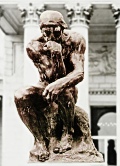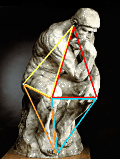|
|
The Toronto Symposium
In the framework of this Symposium and the discussion among Rodin experts that followed, we have tried to find out more about the precise provenance and age of these plasters. We also explored their morphological quality, as compared to reference plasters in other collections in Europe and the USA. You can read more about this under www.rodin-web.org/Symp and www.rodin-web.org/Report_ROM, where fragments of a larger report are published. Thinker Project
From our correspondence with one of the other
Symposium speakers, Prof. David Schaff, a discussion thread developed
that focussed on the various plaster Especially in Asia (Taiwan, Korea, Japan, China), this sculpture is currently highly appreciated as a specimen of European art and as an expression of Western rationalism more generally. But when we tried to set up an online overview of the known plaster and bronze copies, we had to learn that many catalogue descriptions are incomplete or even erroneous. You can read our findings on our separate project Website www.PENSEUR.org. How to define the dimensions of a sculpture?Moreover, we found that among Museums, no
uniform method of determining the dimensions of a sculpture has been
agreed upon. Whereas "height" mostly can be easily
defined,
"width" and "depth" measurements of an irregularly
shaped object always depend on subjective choices. Our conclusion was
that only objective geometrical models can accurately describe the
proportions of such an art work. Some plaster versions (like the one in New York) are slightly smaller than others, for example, because they have been cast after an existing bronze cast. Foundry plasters that were duplicated by the foundry workers may be less detailed than corresponding studio or exhibition plasters. Some foundry plasters are worn off by casting processes or have been mollified by chemical agents used in moulding. Some plasters have even been cut apart for transport and were put together again. The bronzes also vary, because the foundries uses different methods (lost wax or sandcasting) and started from different plaster models. All these differences, that may help to answer questions about the real age and provenance of these copies, can only be determined by an exact comparison in three dimensions. In the year 2004 the Thinker enlargement celebrates its 100th anniversary. By now, we are able to present first results comparing the Strasbourg and the Poznan Thinker to each other. We have also documented other Rodin works, especially in smaller European Museum collections, so that they can be compared to each other and to well-known reference models, for example. We also have an invitation to come over to Canada, to examine and document the Rudier Foundry plasters, but the sponsoring of this trip has not been finalized yet. Finally, we have also documented exemplary works by other sculptors, like Carpeaux, Bourdelle, Claudel and Maillol. Our Partners
For the presentation of results over the Internet, we will set up an online Database with a special interactive server technology, created by the Internet service agency Movingworld.de.
Presentation
Special features of our planned internet presentation:
|
|
|
|
|||||||||||



 Therefore, we decided to make
non-contact measurements of Rodin sculptures, that will allow for an
exact morphological documentation of dimensions and surface structures.
Therefore, we decided to make
non-contact measurements of Rodin sculptures, that will allow for an
exact morphological documentation of dimensions and surface structures. 


 Besides,
we co-operate with the Museums we visit, with other cultural heritage
initiatives like the
Besides,
we co-operate with the Museums we visit, with other cultural heritage
initiatives like the